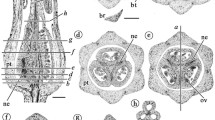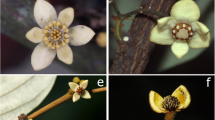Abstract
In at least 4 genera of theMonimiaceae (Tambourissa, Wilkiea, Kibara, Hennecartia) extremely specialized flowers with a hyperstigma occur, i.e. a secretory zone in the narrow entrance of the floral cup. The mucilaginous secretion of the hyperstigma and of the carpels produces a transmitting medium for pollen tubes continuous from the mouth of the floral cup to the ovules. As to their floral morphology, the two extreme types,Hortonia andTambourissa, are connected gradually by various other genera. Possible evolutionary trends and systematic problems are outlined.
Similar content being viewed by others
References
Baillon, H., 1868: Observations sur les Monimiacées. — Adansonia9, 111–134.
, 1869: Monimiacées. In Histoire des plantes1, 289–344. — Paris: L. Hachette.
Barth, Ortrud Monika, 1962: Catálogo sistematico dos pólens des plantes arbóreos do Brazil meridional. II.Monimiaceae eDilleniaceae. — Mem. Inst. Oswaldo Cruz60, 405–419.
Beadle, N.C.W., 1972: Students Flora of North Eastern New South Wales. II. — Armidale, N.S.W.: University of New England.
Bentham, G., Mueller, F., 1870: Flora Australiensis. V. — London: L. Reeve.
De Candolle, A., 1868:Monimiaceae. In Prodromus16, 2, 640–676. — Paris: V. Masson.
Carr, Stella G.M., Carr, D.J., 1961: The functional significance of syncarpy. — Phytomorphology11, 249–256.
Cavaco, A., 1959: Monimiacées. InHumbert, H. (Ed.): Flore de Madagascar et des Comores (Plantes vasculaires)80. — Paris: Firmin-Didot.
Corner, E.J.H., 1949: The durian theory or the origin of the modern tree. — Ann. Bot. (London), n.s.,13, 367–414.
, 1976: The seeds of Dicotyledons. I, II. — Cambridge: University Press.
Ehrendorfer, F., Krendl, F., Habeler, E., Sauer, W., 1968: Chromosome numbers and evolution in primitive Angiosperms. — Taxon17, 337–353.
Endress, P. K., 1972: Zur vergleichenden Entwicklungsmorphologie, Embryologie und Systematik beiLaurales. — Bot. Jahrb. Syst.92, 331–428.
, 1973: Arils and aril-like structures in WoodyRanales. — New Phytol.72, 1159–1171.
, 1975: Nachbarliche Formbeziehungen mit Hüllfunktion im Infloreszenz-und Blüter bereich. — Bot. Jahrb. Syst.96, 1–44.
, 1977: Über Blütenbau und Verwandtschaft derEupomatiaceae undHimantandraceae. — Ber. Deutsch. Bot. Ges.90, 83–103.
, 1979a: Noncarpellary pollination and “hyperstigma” in an Angiosperm (Tambourissa religiosa, Monimiaceae). — Experientia35, 45.
, 1979b: A second species ofSteganthera (Monimiaceae) from Australia. — Blumea25, 315–318.
Gottsberger, G., 1970: Beiträge zur Biologie von Annonaceen-Blüten. — Österr. Bot. Z.118, 237–279.
, 1974: The structure and function of the primitive Angiosperm flower—a discussion. — Acta Bot. Neerl.23, 461–471.
, 1977: Some aspects of beetle pollination in the evolution of flowering plants. — Pl. Syst. Evol., Suppl.1, 211–226.
Grant, V., 1950a: The pollination ofCalycanthus occidentalis. — Amer. J. Bot.37, 294–297.
, 1950b: The protection of the ovules in flowering plants. — Evolution4, 179–201.
Jérémie, J., 1977: Étude desMonimiaceae: Le genreKibaropsis. — Adansonia, n. s.,17, 79–87.
, 1978: Étude desMonimiaceae: Révision du genreHedycarya. — Adansonia, n. s.,18, 25–53.
Johnson, L.A.S., 1962: Taxonomic notes on Australian plants. — Contr. New South Wales Natl. Herb.3, 93–102.
Krattinger, K., 1975. Genetic mobility inTypha. — Aquatic Bot.1, 57–70.
Leinfellner, W., 1966: Über die Karpelle verschiedenerMagnoliales. II.Xymalos, Hedycarya undSiparuna (Monimiaceae). — Österr. Bot. Z.113, 448–458.
Lemesle, R., Pichard, Y., 1954: Les caractères histologiques du bois des Monimiacées. — Rev. Gén. Bot.61, 69–96.
Mangenot, G., 1973: Données élémentaires sur l'angiospermie. — Ann. Univ. Abidjan, sér. E,6, 1.
Mattos, J.R., 1969: Monimiáceas do estado de São Paulo. — Arq. Bot. Estado São Paulo, n.s.,4, 247–258.
Meeuse, A.D.J., 1977: Homologies and convergencies in the floral region. — Ber. Deutsch. Bot. Ges.90, 385–389.
Money, Lillian L., Bailey, I.W., Swamy, B.G.L., 1950: The morphology and relationships of theMonimiaceae. — J. Arnold Arbor.31, 372–404.
Napp-Zinn, K., 1973: Blattanatomie der Angiospermen. 1. InZimmermann, W. et al. (Eds.): Encyclopedia of Plant Anatomy, Spec. Part, VIII, 2A. — Berlin, Stuttgart: Borntraeger.
Peixoto, Ariane Luna, 1976:Monimiaceae do Brasil. O gêneroHennecartia Poisson. — Bradea2 (13), 71–77.
Pass, A., 1940: Das Auftreten verholzter Zellen in Blüten und Blütenknospen I, II. — Österr. Bot. Z.89, 119–164, 169–210.
Perkins, Janet, 1898: Beiträge zur Kenntnis derMonimiaceae 1. Über die Gliederung der Gattungen derMollinedieae. — Bot. Jahrb. Syst.25, 547–577.
, 1900: Monographie der GattungMollinedia. — Bot. Jahrb. Syst.27, 636–683.
, 1911:Monimiaceae (Nachträge). InEngler, A. (Ed.): Das Pflanzenreich. IV. 101. — Leipzig: W. Engelmann.
, 1925: Übersicht über die Gattungen derMonimiaceae sowie Zusammenstellung der Abbildungen und der Literatur über die Arten dieser Familie bis zum Jahre 1925. — Leipzig: W. Engelmann.
, 1901:Monimiaceae. InEngler, A. (Ed.): Das Pflanzenreich. IV. 101. — Leipzig: W. Engelmann.
Pohl, F., 1934: Speichertracheiden in der Narbe und im Griffelende einiger Ericaceen. — Ber. Deutsch. Bot. Ges.52, 203–207.
Poisson, J., 1885a: Sur le genre nouveauHennecartia de la famille des Monimiacées. — Bull. Soc. Bot. France32, 38–42.
, 1885b: Étude sur le nouveau genreHennecartia de la famille des Monimiacées. — Paris: P. Dupont.
Reitz, R., 1961: Monimiáceas Catarinenses. — Sellowia13, 117–132.
Rohweder, O., 1967: Karpellbau und Synkarpie bei Ranunculaceen. — Ber. Schweiz. Bot. Ges.77, 376–432.
Sampson, F.B., 1969: Studies on theMonimiaceae. 1. Floral morphology and gametophyte development ofHedycarya arborea J.R. etG. Forst. (subfamilyMonimioideae). — Austral. J. Bot.17, 403–424.
Sassen, M.M.A., 1974: The stylar transmitting tissue.— Acta Bot. Neerl.23, 99–108.
Schodde, R., 1969: A monograph of the familyAtherospermataceae R. BR. — Ph. D. Thesis, University of Adelaide.
, 1970: Two new suprageneric taxa in theMonimiaceae alliance (Laurales). — Taxon19, 324–328.
Smith, L.S., 1969: New species of and notes on Queensland plants. V. — Contr. Queensland Herb.6, 1–25.
Solms-Laubach, H., 1885: Die Geschlechterdifferenzierung bei den Feigenbäumen. — Bot. Zeitung (Berlin)43, 561–572.
Tulasne, L.R., 1855: MonographiaMonimiacearum. — Arch. Mus. Hist. Nat.4, 273–436.
Vasil, I.K., 1975: The pollen tube in the stigma and style. InMohan Ram, H.Y., Shah, J.J., Shah, C.K. (Eds.): Form, structure and function in plants, 202–214. — Nauchandi, Meerut: Sarita Prakashan.
Walker, J. W., 1976: Comparative pollen morphology and phylogeny of the Ranalean complex. InBeck, C.B., (Ed.): Origin and early evolution of Angiosperms, 241–299. — New York, London: Columbia University Press.
Author information
Authors and Affiliations
Rights and permissions
About this article
Cite this article
Endress, P.K. Ontogeny, function and evolution of extreme floral construction inMonimiaceae . Pl Syst Evol 134, 79–120 (1980). https://doi.org/10.1007/BF00985032
Received:
Issue Date:
DOI: https://doi.org/10.1007/BF00985032




